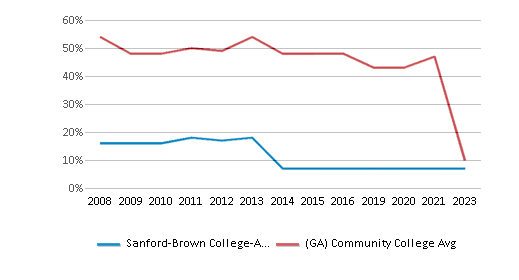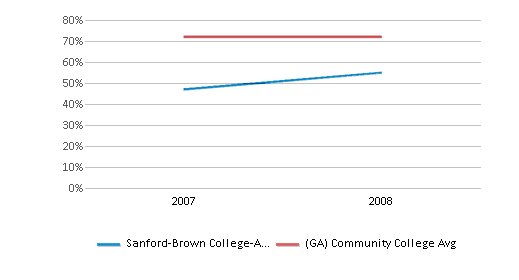School Highlights
Sanford-Brown College-Atlanta serves 428 students (98% of students are full-time).
The college's student:teacher ratio of 31:1 is higher than the state community college average of 18:1.
Minority enrollment is 93% of the student body (majority Black), which is more than the state average of 61%.
Quick Stats (2025)
- Enrollment: 428 students
- Private-state tuition: $15,050
- Acceptance Rate: 55%
- Student:teacher ratio: 31:1
- Minority enrollment: 93%
- Source: Integrated Postsecondary Education Data System (IPEDS)
Top Rankings
Sanford-Brown College-Atlanta ranks among the top 20% of public schools in Georgia for:
Category
Attribute
Diversity
School Resources
School Overview
The teacher population of 14 teachers has stayed relatively flat over five years.
Sanford-Brown College-Atlanta
(GA) Community College Avg.
Carnegie Classification
Item not available
Associates--Public Rural-serving Medium
Institution Level
At least 2 but less than 4 years
At least 2 but less than 4 years
Institution Control
Private, for profit
Public
Total Faculty
14 staff
209 staff

Student Body
The student population of Sanford-Brown College-Atlanta has stayed relatively flat over five years.
The student:teacher ratio of 31:1 has stayed the same over five years.
The Sanford-Brown College-Atlanta diversity score of 0.96 is more than the state average of 0.71. The school's diversity has grown by 116% over five years.
Total Enrollment
428 students
2,242 students

Student : Teacher Ratio
31:1
18:1

# Full-Time Students
420 students
882 students

# Part-Time Students
8 students
1,722 students



# Enrollment Undergraduate
662 students
299 students
# Full-Time Undergraduate Students
420 students
929 students

# Full-Time Graduate Students
n/a
87 students
# Part-Time Undergraduate Students
8 students
1,891 students
# Part-Time Graduate Students
n/a
53 students
Total Dormitory Capacity
n/a
654 students
% Asian
1%
4%

% Hispanic
1%
10%

% Black
18%
35%

% White
7%
39%

% Hawaiian
n/a
1%
% Two or more races
1%
3%

% Non Resident races
n/a
1%
% Unknown races
72%
7%


Diversity Score
0.96
0.71

College Completion Rate (Students who graduate in less than 4 years)
56%
29%

College Completion Rate (Students who graduate in 4 years or more than 4 years)
n/a
0.2368%
Average Graduate Earnings (10 Years)
$30,300
$29,500

Tuition and Acceptance Rate
The private state tuition of $15,050 is less than the state average of $15,267. The private state tuition has stayed relatively flat over four years.
Private State Tuition Fees
$15,050
$15,267

% Students Receiving Some Financial Aid
100%
93%

Median Debt for Graduates
$9,500
$12,000

Median Debt for Dropouts
$4,750
$5,500

Acceptance Rate
55%
72%

SAT Reading
n/a
465
SAT Math
n/a
450
SAT Writing
n/a
465
ACT Composite
n/a
18
ACT English
n/a
18
ACT Math
n/a
18
ACT Writing
n/a
7
Source: 2023 (or latest year available) Integrated Postsecondary Education Data System (IPEDS)
Frequently Asked Questions
How much does Sanford-Brown College-Atlanta cost?
Sanford-Brown College-Atlanta's private state tuition is approximately $15,050.
What is the acceptance rate of Sanford-Brown College-Atlanta?
The acceptance rate of Sanford-Brown College-Atlanta is 55%, which is lower than the state average of 72%.
What is Sanford-Brown College-Atlanta's ranking?
Sanford-Brown College-Atlanta ranks among the top 20% of community college in Georgia for: Diversity in US community colleges and Percent of students receiving financial aid.
In what neighborhood is Sanford-Brown College-Atlanta located?
Sanford-Brown College-Atlanta is located in the Perimeter Center neighborhood of Atlanta, GA. There are 1 other community '.college.' located in Perimeter Center.
Recent Articles

Obtaining Your Bachelor's Degree at a Community College
Explore the evolving landscape of community colleges offering bachelor's degrees, addressing affordability, accessibility, and workforce needs.

A to Z of Community College Certificates and Courses
From business and healthcare to technology and skilled trades, the article showcases the breadth of options available to students seeking to enhance their knowledge, develop new skills, or pursue career advancement.

What is a Community College?
This comprehensive guide explains what a community college is, its history, and its role in higher education. It covers the types of programs offered, differences from four-year colleges, benefits of attending, and important considerations for prospective students, providing valuable insights for those exploring educational options.





